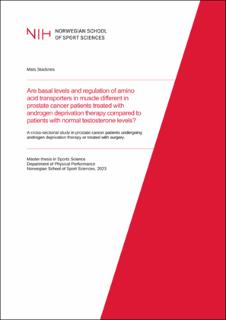| dc.description.abstract | Background: Prostate cancer patients receiving androgen deprivation therapy (ADT) often experience negative side effects influencing the quality of life, such as loss of muscle mass. Resistance exercise has been proposed to counteract this loss of muscle mass. However, literature shows a blunted anabolic response in patients on ADT when compared to the expected response to resistance exercise in elderly.
Purpose: The purpose of this study was to compare the basal levels of amino acid transporters in muscle and the acute regulation of amino acid transporters in response to protein supplementation and resistance exercise between prostate cancer patients receiving ADT treatment and prostate cancer patients with normal testosterone levels.
Method: The study was a single-blind, controlled acute study including 20 prostate cancer patients, 10 receiving ADT treatment (ADT group) and 10 treated with surgery (OPR group). The participants were subjected to an accustoming day before executing two resistance exercise sessions, and one acute day with protein supplementation, resistance exercise and muscle biopsies. Resistance exercise sessions consisted of 3 series of 10 repetitions in the exercises: one-legged leg press, one-legged knee extension, chest press, and seated row, where the left leg operated as control (not trained). On the acute day, participants received two standardized protein supplementations and completed one last resistance exercise session. Muscle biopsies were collected from m. vastus lateralis, first in a fasted state in the not trained leg, two hours post supplementation in both legs, and two hours post resistance exercise in combination with supplementation from both legs. Muscle tissue was fractionated and analysed by western blot for regulators of amino acid transporters eIF2α, and ATF4, and the amino acid transporters CD98-, and SLC38A9.
Results: There were no difference between groups in protein expression for eIF2α, ATF4, and SLC38A9 at baseline, but CD98 levels in the ADT group were higher in the nuclear fraction and lower in the cytosolic fraction compared to the OPR group. There were no differences between groups for protein expression in eIF2α, CD98, ATF4, and SLC38A9 post-supplementation. In the ADT group, there was an increased protein expression for eIF2α in the trained leg post resistance exercise in combination with supplementation in the cytosolic fraction, and a decrease in the untrained leg in the membrane fraction. There were no differences between groups in protein expression for CD98, ATF4, and SLC38A9 post-resistance exercise in combination with supplementation.
Conclusion: ADT treated prostate cancer patients had lower basal levels of CD98 in the cytosolic fraction and higher levels in the nuclear fraction compared to patients treated with surgery, but there were no differences between groups in the response to protein supplementation and resistance training. | en_US |
